| ________________
CM . . .
. Volume XXIV Number 35. . . .May 11, 2018

 |
Governance. (Indigenous Life in Canada: Past, Present, Future).
Simon Rose.
Collingwood, ON: Coast2Coast2Coast/Beech Street Books, 2018.
32 pp., pbk., hc., PDF & HTML, $14.95 (PBK. LST), $11.96 (PBK. DISC), $29.95 (HC. LST), $23.96 (HC. DISC).
ISBN 978-1-77308-179-3 (pbk.), ISBN 978-1-77308-119-9 (hc.), ISBN 978-1-77308-239-4 (PDF), ISBN 978-1-77308-278-3 (HTML).
Subject Headings:
Native peoples-Canada-Politics and government-Juvenile literature.
Native peoples-Canada-Government relations-Juvenile literature.
Grades 3-7 / Ages 8-12.
Review by Dawn Opheim.
**1/2 /4
|
| |
|
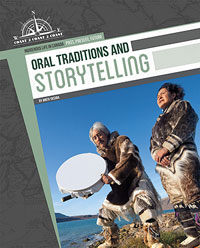 |
Oral Traditions and Storytelling. (Indigenous Life in Canada: Past, Present, Future).
Anita Yasuda.
Collingwood, ON: Coast2Coast2Coast/Beech Street Books, 2018.
32 pp., pbk., hc., PDF & HTML, $14.95 (PBK. LST), $11.96 (PBK. DISC), $29.95 (HC. LST), $23.96 (HC. DISC).
ISBN 978-1-77308-180-9 (pbk.), ISBN 978-1-77308-120-5 (hc.), ISBN 978-1-77308-240-0 (PDF), ISBN 978-1-77308-279-0 (HTML).
Subject Headings:
Oral tradition-Canada-Juvenile literature.
Oral history-Canada-Juvenile literature.
Native peoples-Canada-Folklore-Juvenile literature.
Storytelling-Canada-Juvenile literature.
Folklore-Performance-Juvenile literature.
Collective memory-Canada-Juvenile literature.
Grades 3-7 / Ages 8-12.
Review by Dawn Opheim.
***1/2 /4
|
| |
|
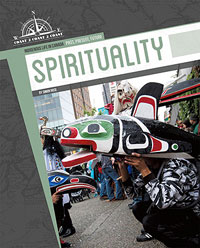 |
Spirituality. (Indigenous Life in Canada: Past, Present, Future).
Simon Rose.
Collingwood, ON: Coast2Coast2Coast/Beech Street Books, 2018.
32 pp., pbk., hc., PDF & HTML, $14.95 (PBK. LST), $11.96 (PBK. DISC), $29.95 (HC. LST), $23.96 (HC. DISC).
ISBN 978-1-77308-182-3 (pbk.), ISBN 978-1-77308-122-9 (hc.), ISBN 978-1-77308-242-4 (PDF), ISBN 978-1-77308-281-3 (HTML).
Subject Headings:
Native peoples-Canada-Religion-Juvenile literature.
Native peoples-Canada-Folk lore-Juvenile literature.
Native peoples-Canada-Rites and ceremonies-Juvenile literature.
Native peoples-Canada-Social life and customs-Juvenile literature.
Grades 3-7 / Ages 8-12.
Review by Dawn Opheim.
***1/2 /4
|
| |
|
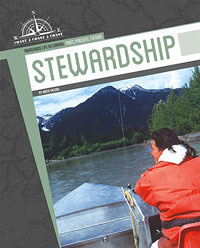 |
Stewardship. (Indigenous Life in Canada: Past, Present, Future).
Anita Yasuda.
Collingwood, ON: Coast2Coast2Coast/Beech Street Books, 2018.
32 pp., pbk., hc., PDF & HTML, $14.95 (PBK. LST), $11.96 (PBK. DISC), $29.95 (HC. LST), $23.96 (HC. DISC).
ISBN 978-1-77308-181-6 (pbk.), ISBN 978-1-77308-121-2 (hc.), ISBN 978-1-77308-241-7 (PDF), ISBN 978-1-77308-280-6 (HTML).
Subject Headings:
Traditional ecological knowledge-Canada-Juvenile literature.
Native peoples-Ecology-Canada-Juvenile literature.
Native peoples-Land tenure-Canada-Juvenile literature.
Environmental management-Canada-Juvenile literature.
Grades 3-7 / Ages 8-12.
Review by Dawn Opheim.
*** /4
|
| |
|
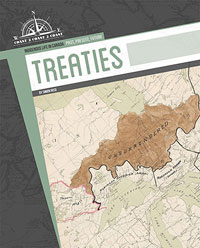 |
Treaties. (Indigenous Life in Canada: Past, Present, Future).
Simon Rose.
Collingwood, ON: Coast2Coast2Coast/Beech Street Books, 2018.
32 pp., pbk., hc., PDF & HTML, $14.95 (PBK. LST), $11.96 (PBK. DISC), $29.95 (HC. LST), $23.96 (HC. DISC).
ISBN 978-1-77308-183-0 (pbk.), ISBN 978-1-77308-123-6 (hc.), ISBN 978-1-77308-243-1 (PDF), ISBN 978-1-77308-282-0 (HTML).
Subject Headings:
Native peoples-Canada-Government relations-Juvenile literature.
Native peoples-Canada-Treaties-Juvenile literature.
Native peoples-Land tenure-Canada-Juvenile literature.
Native peoples-Legal status, laws, etc.-Canada-Juvenile literature.
Grades 3-7 / Ages 8-12.
Review by Dawn Opheim.
*** /4
|
| |
|
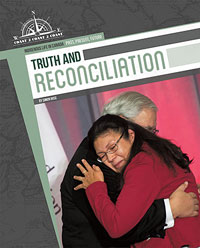 |
Truth and Reconciliation. (Indigenous Life in Canada: Past, Present, Future).
Simon Rose.
Collingwood, ON: Coast2Coast2Coast/Beech Street Books, 2018.
32 pp., pbk., hc., PDF & HTML, $14.95 (PBK. LST), $11.96 (PBK. DISC), $29.95 (HC. LST), $23.96 (HC. DISC).
ISBN 978-1-77308-184-7 (pbk.), ISBN 978-1-77308-124-3 (hc.), ISBN 978-1-77308-244-8 (PDF), ISBN 978-1-77308-283-7 (HTML).
Subject Headings:
Native peoples-Canada-Residential schools-Juvenile literature.
Truth and Reconciliation Commission of Canada-Juvenile literature.
Native peoples-Canada-Government relations-Juvenile literature.
Indians, Treatment of-Canada-Juvenile literature.
Canada-Race relations-Juvenile literature.
Canada-Ethnic relations-Juvenile literature.
Canada-Race relations-Juvenile literature.
Grades 3-7 / Ages 8-12.
Review by Dawn Opheim.
** /4
|
| |
|

excerpt:
Elders have an important role in oral traditions. Each culture has its own word for elders. The Anishinaabek also call them knowledge holders because they have a deep understanding of their community’s history and culture. As teachers they pass on their knowledge of oral history. They may tell stories about values and traditions. Many communities are working to protect elders’ voices. One way they do so is by preserving their oral histories. Often this is in the form of videos or writing.
In Saskatchewan, researchers asked elders to tell their life stories. The elders were from the Dakota, Nakawe, Dene, Lakota, and Swampy Cree First Nations. They shared stories from their childhood. Some explained how they taught their language in their communities’ schools. An elder from the Whitecap Dakota Nation spoke about their teachings. The interviews were put online so their stories could reach more people. (From Oral Traditions and Storytelling.)
“Indigenous Life in Canada: Past, Present, Future”, a six book series, “reveals the challenges Indigenous Peoples face, celebrates their diverse cultures, and highlights the contributions they make to Canada”. These titles focus on the curricular ideas of cause, consequence, and change, and range from oral traditions and storytelling to spirituality to treaties to the modern and relevant topic of Truth and Reconciliation. Each book consists of 32 pages divided into six chapters, with a glossary and index at the end. Also included at the end is a page called “To Learn More” which lists additional books and websites (three of each) to further learning or complement the information from each book. This series also hosts a plethora of additional nonfiction text features that will complement reading and learning: table of contents, chapter titles, headings, paintings/drawings, photos, framing questions, maps, captions/labels, bold or italicized print, inserts or sidebars, and charts.
Governance describes how Indigenous peoples were traditionally self-governed through chiefs, councils of elders, and by voting on the things that were best for their individual nations. Simon Rose touches on a few individual examples of specific Indigenous Nations and what they have done (either in the past or present) with their own governance. In Governance, Rose moves on to discussing initial treaties and how the formation of Canada replaced the traditional forms of Indigenous self-governance in 1867 with prescribed laws that were incorporated into the Indian Act. Over 100 years later, Indigenous Peoples finally began working together with the federal government to ensure that their voices were heard to defend their rights to things like land ownership, culture, natural resources, and education. There are a few Indigenous communities that have reestablished their right to self-govern in modern society, with the most notable being Nunavut, and there are ongoing negotiations for many more.
In Oral Traditions and Storytelling, Anita Yasuda attempts to maintain a precarious balance between sharing ‘generalities’ about First Nations customs around oral traditions and storytelling while still giving specifics where possible. As an example, Yasuda talks about how First Nations people, in general, have elders who are knowledge keepers, and they each have their own origin stories, but Yasuda goes on to briefly summarize a couple of specific origin stories and explain how certain nations are attempting to record their elders’ knowledge. This is a title within the series that is extremely interesting because it touches on things like history and place names, recalling history through song, and contemporary voices in storytelling, but it is also somewhat awkward because it is so brief and superficial. This title could have been ten times longer than it was and still not have covered everything. Nonetheless, Yasuda does a good job in piquing readers’ interests with the items she is able to mention. Hopefully this title inspires readers to seek out additional knowledge beyond this book because the examples and artwork presented in it are truly fascinating even though they are far too brief.
Spirituality is very similar to Oral Traditions and Storytelling in that it touches briefly on generalities while giving some specific examples here and there. This title explores the idea of animals and the ‘circle’ and their importance, how most Indigenous Peoples believe in some sort of Creator and creation, spiritual ceremonies and rituals (which includes smudging, healing circles, and medicine bundles), and sweat lodges. One particularly interesting chapter in this book is the one on shamans – both traditional and modern day shamans. Simon Rose also touches on modern spiritual practices, including the Sun Dance and modern sweat lodges, and how non-Indigenous people are beginning to be influenced by traditional Indigenous spirituality with regard to environmentalism and traditional medicines. This book should also encourage readers to seek additional information beyond its pages because the snippets are so interesting, yet brief.
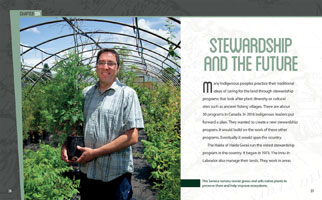 While Anita Yasuda once again gives specific examples in Stewardship, readers get the impression that this is a more comprehensive title and that the issues faced by Indigenous Peoples regarding environmental and animal sustainability, land ownership, and resource management are universal and ongoing. This title explores modern problems faced by Indigenous Peoples, including access to clean and safe drinking water, water pollution in general, and protests surrounding pipelines. Yasuda also looks at the direct connection of land and resources to cultural identity, and how (slowly) the rights to land and resources are being returned to Indigenous Peoples. The last section in this title talks about youth and stewardship, and this topic should really have a larger section in the book (or even be a book on its own). This section could help inspire youth from all cultures to take more ownership in the protection and maintenance of the environment.
While Anita Yasuda once again gives specific examples in Stewardship, readers get the impression that this is a more comprehensive title and that the issues faced by Indigenous Peoples regarding environmental and animal sustainability, land ownership, and resource management are universal and ongoing. This title explores modern problems faced by Indigenous Peoples, including access to clean and safe drinking water, water pollution in general, and protests surrounding pipelines. Yasuda also looks at the direct connection of land and resources to cultural identity, and how (slowly) the rights to land and resources are being returned to Indigenous Peoples. The last section in this title talks about youth and stewardship, and this topic should really have a larger section in the book (or even be a book on its own). This section could help inspire youth from all cultures to take more ownership in the protection and maintenance of the environment.
In Treaties, Simon Rose gives a very good basic introduction to what treaties are and the fact that treaties actually existed before European settlers came to Canada. Early treaties between Indigenous Peoples were often oral, but they were sometimes recorded on birch bark or woven into wampum belts, and they identified specific territories and customs of individual nations. When settlers arrived in Canada, treaties were formed to establish peace, to distribute land, and to utilize natural resources. However, many conflicts rose from treaties because of the differing viewpoints on ‘ownership’ – Indigenous Peoples didn’t realize they were ‘giving up’ their land as they didn’t see land as something that could be owned or given while settlers assumed that by signing treaties they were gaining ownership of the land. This title also discusses modern day treaties, which many may not be aware are still being negotiated, as well as the future of treaties and how and why they may need to be renegotiated.
Truth and Reconciliation is an important and relevant topic in today’s society where most people still don’t seem to have a clear understanding of what it means or what it encompasses. I confess that I am one of those people who is still becoming educated about Truth and Reconciliation, and so I don’t claim to be an expert on this topic. However, I found Truth and Reconciliation to be somewhat mistitled and also somewhat underwhelming with regard to the information it provided about Truth and Reconciliation, itself. Because the majority of the book focused on residential schools and the negativity and injustices surrounding this aspect of history, I felt the book would have been more accurately titled ‘Residential Schools’. Additionally, this book has language and concepts in it that are more difficult than the other books in the series, making it more suitable to a slightly older age. Even though a large part of Truth and Reconciliation is residential schools, Rose seems to have missed the mark with Truth and Reconciliation. This title may have been better as a ‘basic’ book explaining exactly WHAT ‘truth’ and ‘reconciliation’ are (neither word is in the glossary), explaining the calls to action, and explaining more about what Truth and Reconciliation hopes to accomplish. As someone with a limited understanding of Truth and Reconciliation, I didn’t feel like this title helped to further my understanding. However, it was a highly informational text about residential schools and provides a general overview of Truth and Reconciliation if you have no prior knowledge.
The “Indigenous Life in Canada: Past, Present, Future” series attempts to tackle a lot of large topics and to break them down in a way that younger learners can understand. The unfortunate downfall of this series is that there are so many different Indigenous Peoples that it is dangerous to become too generalized because each nation has its own specific cultures and traditions; however, it is impossible to become too specific because the books would then become much too long! This series also would have benefitted from a ‘pronunciation’ guide as many of the names are difficult to pronounce. Overall though, the authors do a good job of providing broad generalities where they are able and also providing interesting specifics which will hopefully entice readers into pursuing more learning about the areas that interest them. This series is accurately labelled as juvenile literature and would be best suited for grades 3-7 (depending on reading level and needs, and some of the individual titles are slightly easier or harder). These titles offer useful information as well as offering good examples of nonfiction text features for educational use.
Governance - Recommended.
Oral Traditions and Storytelling - Highly Recommended.
Spirituality - Highly Recommended.
Stewardship - Recommended.
Treaties - Recommended.
Truth and Reconciliation - Recommended.
Dawn Opheim, an avid reader with a Masters degree in Teacher-Librarianship, works at two elementary school libraries in Saskatoon, SK.

© CM Association
CC BY-NC-ND
Hosted by:
University of Manitoba
ISSN 1201-9364
|
This Creative Commons license allows you to download the review and share it with others as long as you credit the CM Association. You cannot change the review in any way or use it commercially.
Commercial use is available through a contract with the CM Association. This Creative Commons license allows publishers whose works are being reviewed to download and share said CM reviews provided you credit the CM Association. |
Next Review | Table of Contents for This Issue - May 11, 2018.
CM Home | Back Issues | Search | CM Archive | Profiles Archive
|






 While Anita Yasuda once again gives specific examples in Stewardship, readers get the impression that this is a more comprehensive title and that the issues faced by Indigenous Peoples regarding environmental and animal sustainability, land ownership, and resource management are universal and ongoing. This title explores modern problems faced by Indigenous Peoples, including access to clean and safe drinking water, water pollution in general, and protests surrounding pipelines. Yasuda also looks at the direct connection of land and resources to cultural identity, and how (slowly) the rights to land and resources are being returned to Indigenous Peoples. The last section in this title talks about youth and stewardship, and this topic should really have a larger section in the book (or even be a book on its own). This section could help inspire youth from all cultures to take more ownership in the protection and maintenance of the environment.
While Anita Yasuda once again gives specific examples in Stewardship, readers get the impression that this is a more comprehensive title and that the issues faced by Indigenous Peoples regarding environmental and animal sustainability, land ownership, and resource management are universal and ongoing. This title explores modern problems faced by Indigenous Peoples, including access to clean and safe drinking water, water pollution in general, and protests surrounding pipelines. Yasuda also looks at the direct connection of land and resources to cultural identity, and how (slowly) the rights to land and resources are being returned to Indigenous Peoples. The last section in this title talks about youth and stewardship, and this topic should really have a larger section in the book (or even be a book on its own). This section could help inspire youth from all cultures to take more ownership in the protection and maintenance of the environment.